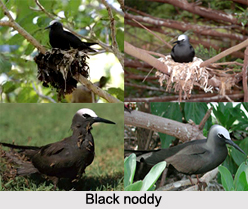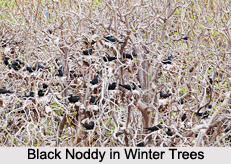 Black Noddy or White-Capped Noddy is an Indian bird and it has a scientific name "Anous minutes" is a seabird from the tern family.
Black Noddy or White-Capped Noddy is an Indian bird and it has a scientific name "Anous minutes" is a seabird from the tern family.
Size of Black Noddy
Black Noddy is a medium-sized bird with black plumage and a white cap. It resembles the closely related brown or common noddy, but is smaller with darker plumage, a whiter cap, a longer, straighter beak and shorter tail. It was at one time, and sometimes still is, thought to be identical with this species.
Structure of Black Noddy
Black Noddy is a medium-sized tern with a length of about 37 centimetres, a wingspan of about 70 centimetres and a weight of 98 to 144 grams. It has black plumage and a whitish cap, a small white crescent under each eye and a white spot above. It has long tapering wings and a truncated tail. The sharply-pointed bill is black as are the feet, which are fully webbed.
Behaviour of Black Noddy
Black Noddy may have known as "noddies" because of the behaviour of both sexes as they constantly dip their heads during their breeding display. They are very tolerant of humans even to the extent that they can be picked up off the nest. They feed on fish and squid which they gather by flying low over the surface of the sea and picking them up. They may associate with other seabirds in areas where predatory fish are driving small fish to the surface.
Nests of Black Noddy
The nests of Black Noddy consist of a level platform, often created in the branches of trees by a series of dried leaves covered with bird droppings. One egg is laid each season, and nests are re-used in subsequent years. The guano produced by these birds adds large quantities of nutrients to the soil which is of great importance to the plant communities on coral islands.
One egg is laid each season, and nests are re-used in subsequent years. The guano produced by these birds adds large quantities of nutrients to the soil which is of great importance to the plant communities on coral islands.
Distribution of Black Noddy
Black Noddy has a worldwide distribution in tropical and subtropical seas, with colonies widespread in the Pacific Ocean and more scattered across the Caribbean, central Atlantic and in the northeast Indian Ocean. At sea it is usually seen close to its breeding colonies within 80 kilometres of shore. Black Noddy returns to their colonies or to other islands in order to roost at night.



















